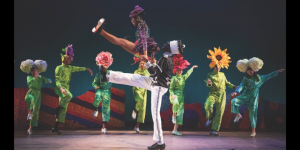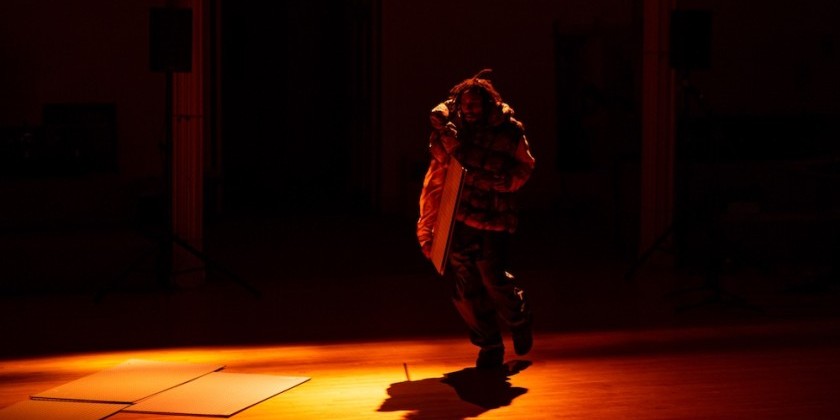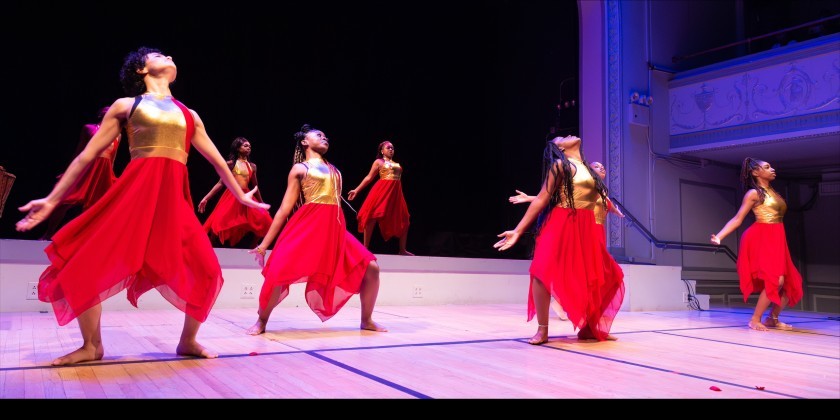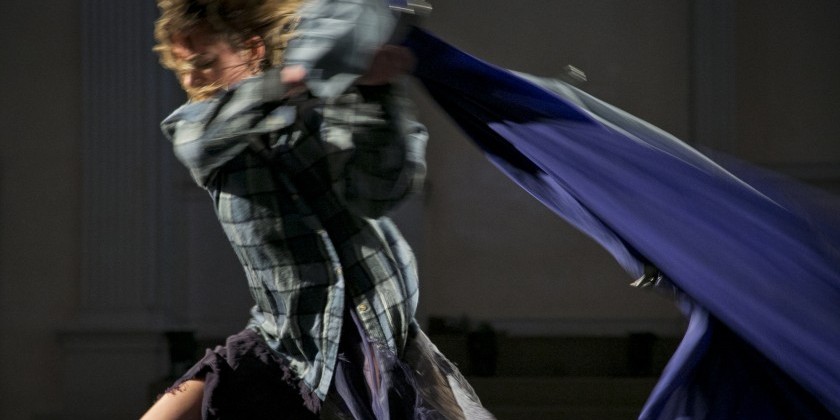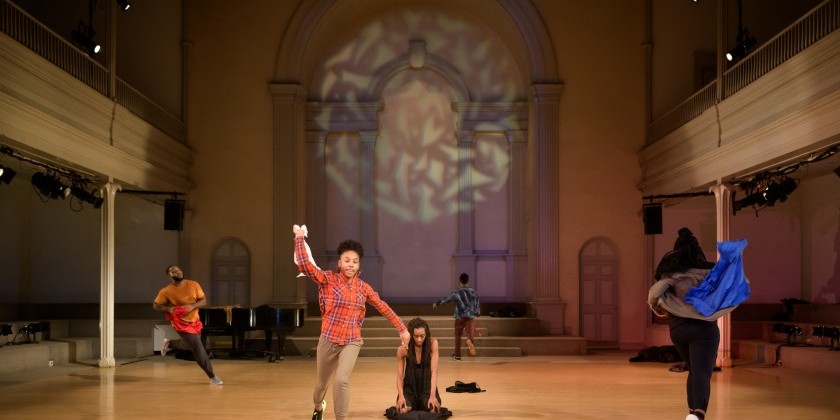Edisa Weeks of Edisa Weeks/Delirious Dances on Her Three-Part Work “Three Rites: Life, Liberty, Happiness”
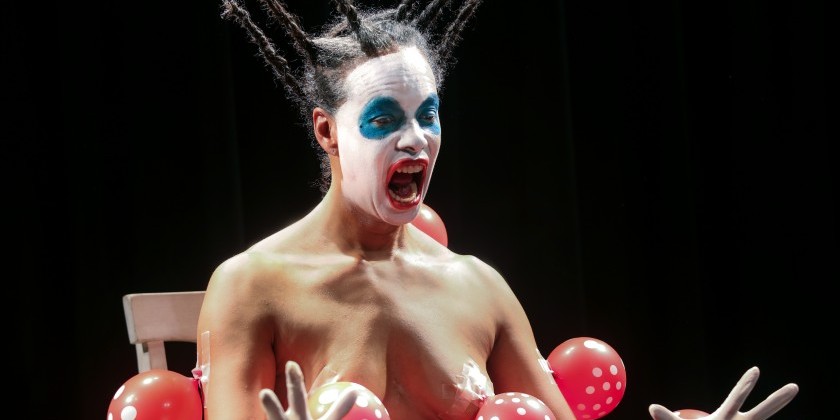
"Liberty" is part of SUITE Space residency Show at Mabou Mines
SUITE Space residency Show at Mabou Mines (122 CC 1st Ave, NYC 10009 - 2nd Fl.)
February 4- 6, 2019
7pm - THREE RITES: Liberty by DELIRIOUS Dances/Edisa Weeks
8:30pm - decolonizing my vagina by Cristina Pritter
Tickets $15, Students/Seniors $10 - https://www.maboumines.org/suite-space/
Multi-disciplinary artist Edisa Weeks and her Delirious Dances are in the midst of a multi-year project, Three Rites: Life, Liberty, Happiness. This week, she’ll be sharing one of the sections, Liberty, an installation and solo for Weeks who inhabits white and black face. Attached to her body like puppet appendages are objects that can be associated with Black life in America, including a bible, gun, and watermelon, to name a few.
Weeks, who sees dance and performance as a spiritual and communal practice, aims to have her audience members see one another in performance in an effort to gain an understanding of each other’s experiences. “If I had my way I would develop an empathy drug, and would crop dust it everywhere,” she says.
Weeks spoke to The Dance Enthusiast before her latest Liberty showing. These our excerpts from our conversation.
Trina Mannino for The Dance Enthusiast: How had growing up in three cultures — Uganda, Papua New Guinea, and Brooklyn — shape your work as an artist and the way you view the world around you?
Edisa Weeks: I’ve learned to eat anything and not to be picky [laughs]. In other cultures, more so than here in the States, food is such an important part of connecting and being with people. Having a wide palate for a variety of foods is so important. If a community goes out of its way to make a meal, it would be a sign of disrespect not to eat it.
In Papua New Guinea, for example, my Dad traveled a lot — he was doing research on education for the university and government there. I had the opportunity to go with him sometimes. We would go to these very small villages, and they would go out of their way to prepare food for us. . .
This taught me to be open to differences. And within our differences, how can we find commonality? Even though we may not speak the same language, what are other ways we can communicate? Physical gesture is one of the ways that we can. That’s one of the things that I love about dance is that it can be really transcendent. We all have bodies. How can we share information via body? Movement also informs the way we think. For example, infants’ movements are crucial for brain development. How can movement help communicate something about a person or a culture and be a way of exchanging?
The Dance Enthusiast: This week at Mabou Mines, we’ll be seeing Liberty as a work-in-progress, one of three sections of Three Rites: Life, Liberty, Happiness, which is premiering in June 2020. Can you talk about the genesis of this project?
Edisa Weeks: It’s part of what I call my Americana series, which includes my previous piece, To Begin the World Over Again about Thomas Paine. Its title comes from one of his quotes that strangely was often used a lot by Conservatives on the Right and Ronald Reagan. . . Thomas Paine was one of the people who coined the phrase ‘The United States of America’ and really helped promote the promise of this country. While doing research for that work, I read the Declaration of Independence again, and it made me think: How do you guarantee life, liberty, and happiness? Why put that in a legal document?
For me as a Black woman, who is American but has a parent from Uganda, I still had to learn a lot of American history. I wasn’t necessarily taught all of it by my parents. Reading these documents in the era of Black Lives Matter and Citizens United . . . was fascinating. When you think about how America has the highest incarceration rate of any industrialized nation, what does the concept of liberty really mean?
Also, thinking about the War in the Middle East, particularly in Afghanistan which we’re going into its 18th year, how are we really guaranteeing liberty and who is liberty really for? How is America living up to these ideals at home and also overseas? . . .
I think the ideals are rich, necessary, and needed. Yes, we all deserve the right to a decent life. But, what are the actual steps that are needed to make that a reality, not for a few but for ideally all Americans.
While doing the research around happiness, it was fascinating to learn, for example, that in the 1930s corporations and psychologists together figured out ways to market the purchasing and ownership of ‘stuff’ as a source of happiness. Buy this car, this beer, these diamonds. But what current research is pointing to is that the pursuit of happiness actually stresses people out and makes them unhappy. What really makes people happy are moments of being together, sharing a meal, connecting with community, and volunteering where you feel you’ve contributed to another person’s life in a positive way. It’s laughing. . .
The Dance Enthusiast: In your previous work there is often a blurring of audience and performance space and an emphasis on community. This also seems to be the case in Three Rites. Can you talk about your interest in bringing community into performance?
Edisa Weeks: I love proscenium, but I also feel like it’s dead in the sense of how it engages the community. You can be sitting two feet away from someone in the audience — you’re even touching shoulders with people who are sitting on either side of you — but you’re not talking to them. It can be a very one-way relationship [between performer and audience member] . . . You’re not necessarily dialoguing with one another.
What I love about going out to a club or experiencing more traditional folk forms is that you are engaging in something collectively. . . There’s this sense that we’re in this together instead you’re here as an observer. . . In my work I’m interested in how to make the audience have agency and make choices within a performance.

The Dance Enthusiast: You’ve been working on this series for the past four years and started around the time of the election of Trump. Your work has always a through-line of themes of community, your Black female identity, and politics. Has Three Rites been especially impacted by the current administration and the agenda its set forth?
Edisa Weeks: As a Black person and a woman having this president is no different from what I had to deal with when Barack was in power or Clinton or Bush . . . Having a Black president didn’t mean oppression had ended or even if we had elected a female president it wouldn’t mean the end of sexism. As someone who has progressive values, yes it was upsetting to have someone as the commander in chief, the leader of our country, to be so disconnected from progressive values. But, for me it highlighted that as a nation we became complacent. . . A lot of what’s happening under the 45th president has always been there. It’s just more on the surface, which, when it’s on the surface, we can address it.
What’s influenced me more is my work as an educator where I’m seeing students on anti-depressants and dealing with stress-related illnesses. . . Our country’s focus on capitalism and the ‘I’ verses the ‘We’ is incredibly detrimental, not only psychologically but also in our sense of wellness and health. . .Through my work as a teacher and seeing what my students are going through, I’m seeing a need to engage with community and to connect with a sense of spirituality. . . We are spiritual beings, whether we acknowledge that or not. How does movement connect to the spiritual and communal? Community is a way into that. This is what I’m trying to figure out . . . How can I create rituals of engagement where people can see one another? . . . These [questions and ideas] have influenced me more than the political climate.
The Dance Enthusiast: How do you see the work transforming over the course of the next year leading up to the official premiere?
Edisa Weeks: I haven’t done a full installation of all the roots [in Liberty, Weeks has designed a hanging installation with 1865 tree roots made out of paper and twine representing the year that legalized chattel slavery ended in America]. Written on the roots are reflections on liberties. I was able to test this out with about 80 roots during my 2017 BRIC residency. . . I’m spending this year how people will move through the installation and then discover my ‘Liberty’ character. . .
In Happiness I’m figuring out how do we cultivate wellness and rejuvenation in order to do the hard work of undoing systemic structures of racism and oppression? Without joy and taking the time to breath, that work becomes impossible.
And with the dancers, how do the abstract concepts I’ve been discussing translate to movement? That’s always my struggle. . . I’ll be focusing on Life, which will be split into parts, a mural, a dance, and discussions. . .
The three sections will take place at separate venues in the same evening. How do I coordinate transitions for audience members? Do I need to include a break out session? How much space to give people time to think and reflect about what they’ve seen?
The Dance Enthusiast Asks Questions and Creates Conversation.
For more of The Dance Enthusiast Asks, click here.







